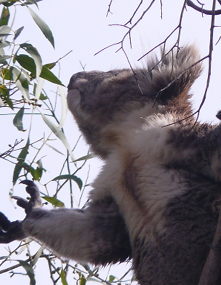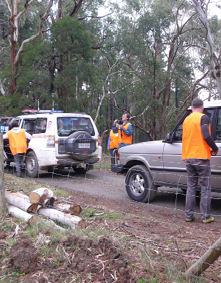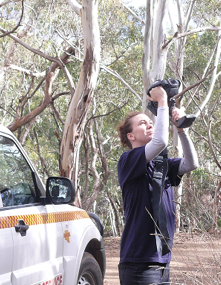Post disaster recovery arrangements for animals in South Australia
Rachel Westcott, Emilis Prelgauskas
Abstract
| Animal welfare is one of the targets in emergency response arrangements. This report outlines the evolution in structures and processes put in place for animal rescue, triage, treatment and return in South Australia. These arrangements are integral to the State Emergency Management Plan (Government of South Australia, 2012), and outlines how management of animals in emergencies impacts on the preservation of human life (Thompson 2012). This paper is a description of the current in-field state of this emerging discipline. |
Article
Introduction
In South Australia, the formation and operation of South Australian Veterinary Emergency Management (SAVEM) has driven the awareness across the sector for a structured response to animal welfare in an emergency incident. An entry in the 2012 Resilient Australia Awards, netted SAVEM a State Winner in the South Australian division and a Highly Commended in the national event.
Why we care about animals
The iconic visual image beamed around the planet after the 2009 Victorian fires was the photo of ‘Sam’ the koala being given water by a Country Fire Authority (CFA) firefighter. Images from the Queensland
2010-11 floods showed incidents where people at risk were reluctant to board evacuation boats or helicopters because their companion animals were being left behind (Thompson 2012). People care about animals. Actions in support of the innocent prove that, at times of distress, humans are capable of acting in the broader interest beyond personal self interest or survival.
Processes which include the rescue of animals post-event are a key input which encourages people at risk to make evacuation decisions in a timely manner. Processes which take the care for animals into consideration have a direct and beneficial impact on saving human life during an emergency. These aspects are increasingly discussed (see Barrett & Elks 2013).
There is a common misconception that animal welfare and veterinary involvement in the care of animals in an emergency can be locally delivered yet managed from a national or international platform. In Australia the jurisdictional framework within which emergency services organisations work, is state-based and its structure has to suit the particular legislative setting in the local context. National and international endeavours are not directly translatable. Similarly, while some academic work (Wenzel 2007, Wingfield & Palmer 2009) has been undertaken regarding management of animals in natural disasters, the reality is that little data has been gathered on animal management in an emergency response in the local context.

‘Sam’ the Koala receiving a drink from CFA volunteer, David Tree.
Background - South Australia’s State Emergency Management Plan (SEMP)
South Australia has emergency management legislation and an emergency management plan that is, effectively, a set of regulations under the State Emergency Management Act 20041. The Commissioner of Police implements protocols described in the Australasian Interservice Incident Management System™ (AIIMS™) at both State Emergency Centre level and within each of the responding agencies. The strength of the SEMP lies in its simplicity, flexibility and scope and its ability to suit any emergency profile. The result is a cohesive alliance of all emergency services organisations.
SAVEM is regarded as a ‘participating agency’ within the SEMP, under the Agriculture and Animal Services Functional Service. SAVEM’s own plan describes the structural processes in place which suit the management of animals in the South Australian context.
The SAVEM plan is a useful model for other jurisdictions to assist them to develop their own procedures to suit particular jurisdictional purposes.
Traditional animal agencies
In South Australia, well-known animal welfare agencies such at the RSPCA and the Animal Welfare League are also ‘participating agencies’ in an emergency incident. Within the community the veterinary profession provides day-to-day care for animals owned by citizens and businesses as well as to a range of volunteer-based animal sanctuary community agencies which receive injured animals, including wildlife, for care. During emergencies the involvement with animals can include the Department of Environment, Water and Natural Resources in the management of wildlife, and the Department of Communities and Social Inclusion, where pets accompany displaced people to evacuation shelters and relief centres. However, amongst these diverse contributors, there is no single party that has the processes or the appropriate resources to enter a disaster area post-event and to search for and manage all animals (in particular companion animals, wildlife, and horses) in a wholistic veterinary context in any cohesive way.
2009 – the beginning
Immediately after the 2009 Victorian bushfires, some veterinarians living and working within the disaster area continued to operate their clinics left undamaged by the fires, even though their own homes had been destroyed. These veterinary clinics were the destination for an influx of injured, abandoned or retrieved companion animals and wildlife from the fireground. What was missing was an inflow of the supporting materials and resources to assist and support these efforts.
A collaboration between veterinarians and industry was established to collect and dispatch vital veterinary supplies to the fire-affected area. Within a few days the first of a total of 15 pallets of goods was delivered. Deliveries continued over a three-week period. This was possible through the ready participation of the veterinary supply industry. ProVet SA, conveniently located at Adelaide Airport, canvassed all South Australian vet clinics on their client list for donations. Yellow Couriers donated a van to collect donations from across the metropolitan area. Some clinics chose to donate money which was billed to their accounts and was used to purchase supplies that were pulled from the warehouse shelves to satisfy a list of required items. ProVet SA donated transport and handling. This was the beginning of veterinary emergency management in South Australia.
SAVEM was formally recognised a year later by the South Australia Government’s State Response Advisory Group and its activities became eligible for support from the South Australian Fire and Emergency Services Commission and the Attorney-General’s Department, via the Natural Disaster Resilience Program. This accelerated and broadened the ability of SAVEM as a volunteer not-for-profit agency to make firm its processes and resource base.
All the organisation’s initiatives are volunteer-based, including positions of the web master, consultant clinicians, training officers, and Police liaison.
Team members:
Jan Mahoney, CSIRO, volunteered as the webmaster of the SAVEM web site which is real-time and updateable.
Dr Anne Fowler is an Emergency Veterinarian and highly skilled burns clinician who has been supportive and readily available to SAVEM both in developing organisational skills and technical skills training.
Dr Nancy Bombardieri is a Veterinarian with Biosecurity SA and fills one of the SAVEM Board positions. She is the principal Training Officer for the Level One program, is the point of contact with PIRSA, and develops links with other emergency agencies.
Dr Sam Mead is Executive Officer with SIDSforKids, having worked in a number of senior roles in the not-for-profit sector both nationally and internationally including in the veterinary industry. She offers her organisational expertise to SAVEM.
Sgt Kathy Newman is a Police Officer who assists SAVEM with outreach to other agencies and in Zone Emergency Centre locations.

Image: SAVEM
The koala in an intact tree canopy was healthy. It was located with a thermal imaging camera and checked visually, assisted by zoom photography and binoculars.
SAVEM protocols
SAVEM’s animal rescue, triage, treatment and return protocols were developed between 2009 and 2012 and feature the following:
A formal structure, including formation of the incorporated not-for-profit association SAVEM Inc. The association has a management board and supporting structures and resources.
SAVEM’s formal plan was State Government Assured at the end of 2010. This means that the plan was officially recognised and that SAVEM can apply to the South Australian Government for financial assistance post an event
The SAVEM Plan is written according to AIIMS protocols and principles, common to all other emergency services. SAVEM uses the same intra-State uniform boundaries as other government agencies for consistency and efficiency.
SAVEM has its own South Australian health department drug license to manage the restricted use of S4 and S8 drugs used in the field. SAVEM has alliances with other organisations, such as the SA Hunting and Conservation Branch of the Sporting Shooters Association of Australia, which provides capacity to deal with whatever is found in the field.
The South Australian Veterinary Surgeons Board licenses all veterinarians in the state, and includes in

Image: SAVEM
SAVEM volunteers led by a CFS Command car searched the burned forest the morning after the fire front had passed. Thermal imaging equipment lent to SAVEM by the CFS was used. About 20 mms of rain fell on the fireground overnight.
its annual registration documentation the option to ‘tick the box’ to be notified of a disease outbreak or emergency incident. Approximately 300 veterinarians have done so each year since the inception of this initiative. The SAVEM Board has the ability to advise those veterinarians at the time of an emergency activation via SMS, authorised by the Chief Veterinary Officer or his delegate.
From August 2011 to February 2013, SAVEM had undertaken formal training of 220 volunteers, many of whom are veterinarians, to Level 1 standard. Another 40 were trained to Team Leader standard. This provides a core resource for the response structure including the establishment of control centres, first response teams, and treatment stations.
There has also been training in specialist subjects including treating burns and leadership. Biosecurity South Australia offers training modules in Emergency and Disease Management which are available to all SAVEM volunteers. SAVEM participates in combined exercises with other agencies such as the Department of Community and Social Inclusion’s Ring of Fire exercise in 2011.
Continuing the initiatives with industry formed in 2009, SAVEM activation has direct access to the warehouse of the veterinary wholesaler, ProVet SA, and their courier, transport group Toll, for rapid dispatch of support resources to in-field control centres and operations teams.
SAVEM is inclusive of other general community volunteers through its awareness program. Presentations to community groups and to local emergency services personnel at brigade level are supplemented by informative literature for distribution. This allows cohesion with other agencies, and attracts interested members of the wider community.
SAVEM is actively and consciously engaged in building strong and enduring relationships and alliances with other emergency services organisations as part of an integrated approach to emergency management in South Australia.
Allied expertise contributed by volunteer veterinary nurses and wildlife carers is encouraged and supported, which is evident in their open inclusion in the organisation’s training opportunities.
The result is an established, human resource base from which nominated volunteers can be drawn at the time of response activation. Supporting this is the organisation’s on-going evolution of Standard Operating Procedures, Policy Manual, and resource kits (To Go Kit, or TGKs). Efforts are underway to add to existing private resources with dedicated organisation-based equipment.

Image: SAVEM
SAVEM volunteer and Team Leader, Tamarand Cresswell, searched the tree canopy for koalas using the thermal imaging camera.
Mainstream animal welfare agencies seldom have the at-call resources and the dedicated emergency management training or authorisations under the SEMP, which SAVEM has. SAVEM’s surge capacity is in the 220-plus trained volunteers, volunteers who have registered to attend future training workshops, as well those on the ‘reserve list’ of opt-in veterinarians held by the Veterinary Surgeons Board of South Australia. This capacity of trained and committed volunteers means there are resources to put teams into the field and cycle them throughout the response.
Learning by doing
It is now generally accepted in the emergency management sector that cash donations are the most useful and a most helpful means of assistance, especially where goods can be purchased in or near the affected community. However, at the time of the Victorian fires in 2009, the first load of donations delivered after only two days included pet food, feeding utensils, carrier cages, leads and bedding, as well as veterinary medicines. The South Australian Department for Communities and Social Inclusion (2012) National Guidelines for Managing Donated Goods, was also a category Winner in the 2012 Resilient Australia Awards.
In January 2011, the fire near Wilmington which threatened the small town in the north of South Australia provided the next opportunity for response. SAVEM was still in its formative phase, and resources immediately available were limited to Dr Westcott’s own mobile clinic—a long wheel base Mercedes Sprinter van which is fitted for in-field use and a passenger vehicle.
In November 2011, SAVEM had a First Response Team on standby for the Port Lincoln fires. While the team was not physically deployed, SAVEM offered support and expertise to local Port Lincoln veterinarians. Particularly helpful was the ability to tap into the knowledge of local volunteers who had previously attended a SAVEM workshop in Adelaide. This opened up a network of resources ranging from the very effective City Council Ranger, to private boarding kennels which provided an evacuation haven should animals be shipped out en masse. The location needed commercial flight access which was readily arranged alongside ProVet SA’s Adelaide Airport presence, with one of the local clinics in Port Lincoln providing on-ground support with vehicles. The local freight company office was contacted and offered transport of veterinary emergency material for no charge.
In May 2013, South Australia experienced a bushfire in the Adelaide Hills, known as the ‘Cherryville’ fire, at the end of the official bushfire season. SAVEM was placed on standby on the second morning. A First Response Team was made ready, and the Coordinator travelled to the local Control Centre to better engage with emergency services organisations and to attend public and liaison meetings. Crucial communication was established with Police and Country Fire Services (CFS) personnel. A significant amount of rain that evening saw the majority of responding crews stood down and SAVEM was given permission to enter the fireground. Accompanied by a CFS Command car and CFS personnel, volunteers carried out an all-day search and rescue exercise as a training exercise and as a public service.
The SAVEM team, as one of the early recovery agencies present after an event, gives support to home owners, as much as it carries out the recovery and treatment of injured animals. One resident, whose home was metres from the firefront, had her distress compounded by finding multiple badly burned animals coming out of the blackened forest onto her property for two weeks after the fires. SAVEM was able to alleviate animal suffering and offer the resident support and reassurance (SAVEM Inc. 2013).
The emphasis at all times is on a ‘can do’ attitude. As SAVEM’s organisational arrangements mature, it is expected that more support resources for volunteers will be added. One of the great strengths is the resourcefulness of the team, and as SAVEM’s place in emergency response in South Australia is consolidated, the ability to problem solve effectively and positively as veterinary professionals, alongside nurse and carer volunteers, not only fills the animal welfare void in emergency management, but provides an essential and identifiable community service in human terms.

Image: SAVEM
The fireground the morning after. Typically this was very steep terrain, interspersed with dirt fire tracks, which became slippery after the overnight rain. The CFS Command car went ahead to assess accessibility before the rest of the team followed.
References
Attorney-General’s Department 2012, National Strategy for Disaster Resilience/Companion Booklet, pp. 20-21, Case Study 10-SAVEM.
Barrett, R & Elks, S 2013, Pets dilemma for rescue workers, in The Australian, February 11..
Brennan, B 2012, Murray Valley Standard, Veterinarian rewarded for stepping into disaster, December 4, p. 2.
Broadstock, A 2012, Hills & Valley Messenger, Pet Protector, January 11, p. 1, 4.
Government of South Australia 2012, State Emergency Management Plan.
John Madigan, Director of the International Animal Welfare Training Institute at UC Davis Emergency Preparedness.
Novak, E 2011, SMS Implementation - Emergency Response Plans, in Soaring Australia, January, pp. 42-3.
ProVet SA, Partners in Practice , Veterinarians Emergency Response, Autumn 2013 (March 2013, pp. 28-29).
SAVEM Inc. 2013, Report on the Cherryville Fire.
South Australian Department for Communities and Social Inclusion 2012, National Guidelines for Managing Donated Goods,
Thompson, K 2012, Should I stay or should I go? Personal Communication (Research Proposal – Approved, Central Queensland University).
Wenzel, JGW 2007, Disaster Medicine: Organizational aspects of disaster preparedness and response, in Journal of the American Veterinary Medical Association, no. 11, June 1, pp. 1634-7.
Wingfield, W & Palmer, S (Eds) 2009, Veterinary Disaster Response, Wiley Blackwell.
About the authors
Dr Rachel Westcott is a First Class Honours veterinary graduate of Murdoch University in Perth, Western Australia. She is a Veterinarian in private practice, and the Founder and Coordinator of SAVEM Inc.
Emilis Prelgauskas is an Architect in private practice, and a Commissioner in the South Australian Environment Resources and Development Court. He is a SAVEM Board member and Logistics Manager in SAVEM’s structure.
Further information
For more information about this and other projects, visit the SAVEM website..
1 State Emergency Management Act 2004.


